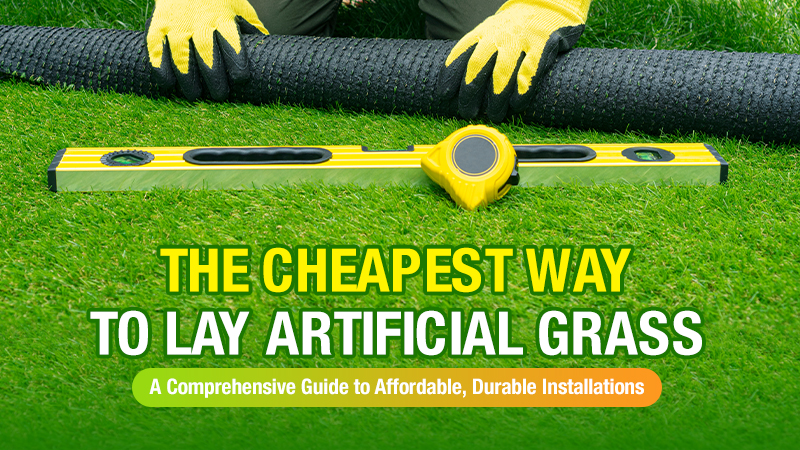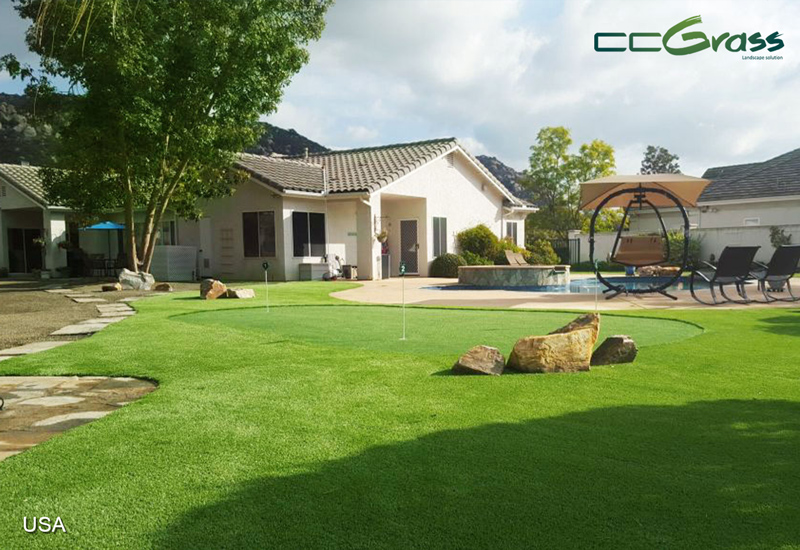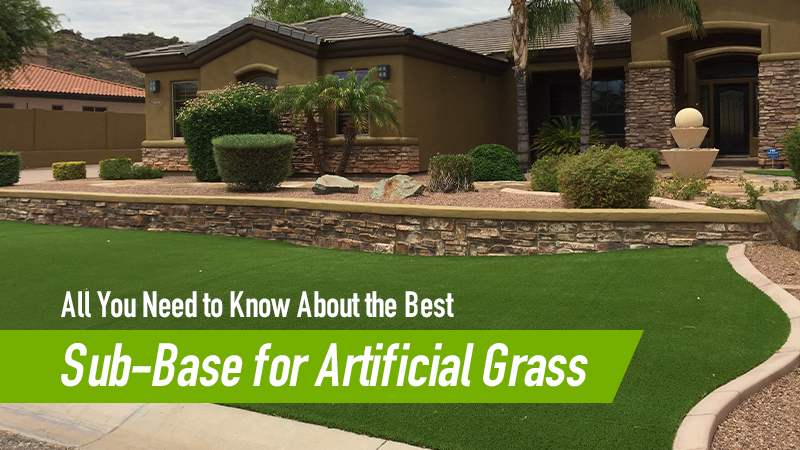The Cheapest Way to Lay Artificial Grass: A Comprehensive Guide to Affordable, Durable Installations
- 05/22/2025
Artificial grass has become a popular solution for a low-maintenance, evergreen lawn. While professional installations can be costly, the cheapest way to lay artificial grass hinges on a budget-friendly approach with careful planning and strategic choices.
This guide dives deep into the most cost-effective methods to lay artificial grass, prioritizing durability and aesthetics without overspending. By focusing on material selection, DIY techniques, and long-term savings, you can transform your space efficiently.

In this article:
1. Selecting Cost-Effective Artificial Grass
The foundation of an affordable installation lies in choosing the right turf. Understanding the yarn material properties and their impact on cost ensures you avoid overspending on unnecessary features.
1.1 Prioritize Shorter Pile Heights
Shorter pile heights (20–35mm) are inherently cheaper than longer, denser varieties. These styles are ideal for decorative areas, patios, or low-traffic zones. While they lack the plushness of premium turf, they provide a clean, uniform appearance and require less infill material.
1.2 Opt for Polyethylene-Based Turf
Polyethylene (PE) turf strikes an ideal balance between durability, comfort, and cost-effectiveness. Softer than nylon and more affordable than hybrid blends, PE turf is a popular choice for residential lawns and recreational areas. It offers a natural appearance and reliable performance, making it a practical and attractive option for everyday use.
1.3 Consider Remnants or Bulk Purchases
Local artificial grass suppliers often sell remnants from larger projects at discounted rates. Measure your area accurately and inquire about leftover stock that matches your dimensions. For larger projects, buying turf in bulk rolls reduces waste and per-square-foot costs.
2. DIY Site Preparation: Cutting Labor Costs
Professional groundwork accounts for up to 50% of turf installation expenses. Tackling this step yourself is central to the cheapest way to lay artificial grass, saving hundreds while ensuring quality.
2.1 Efficient Removal of Existing Vegetation
Clear the area thoroughly to prevent organic matter from decomposing under the turf, which can cause unevenness. Use a sod cutter for large lawns or a shovel for smaller spaces. Dispose of debris responsibly to avoid additional fees.
2.2 Building a Stable, Affordable Base
A compacted base is critical for ensuring proper drainage and long-term durability of artificial grass surface, and opting for cost-effective materials can significantly reduce expenses.
Instead of expensive crushed granite, choose budget-friendly options like Class II Road Base—a blend of crushed rock and fines that compacts efficiently and suits most climates—or Decomposed Granite, a lightweight, permeable alternative ideal for smaller areas.
Begin by excavating the soil to a depth of 3–4 inches, then thoroughly compact the base material using a rented plate compactor to create a firm, level surface that prevents shifting and promotes water runoff. This approach balances affordability with structural integrity, ensuring a stable foundation for your artificial lawn.
2.3 Simplifying Drainage Solutions
While proper drainage is non-negotiable, complex systems aren’t always needed. Slope the base at a 1–2% grade away from structures. For clay-heavy soils, mix sand into the base layer to improve permeability.
Want to dive deeper into proper groundwork? See the guide below for everything you need to know about sub-bases.
3. Streamlining the Installation Process
Professional installers often include optional layers that inflate costs. Focus on essential steps to maintain quality while minimizing expenses.
3.1 Eliminating Non-Essential Layers
Streamlining your installation by omitting non-critical layers reduces costs without sacrificing functionality. Weed barriers, such as landscape fabric, are only necessary in areas prone to invasive weeds or uneven soil, and may be redundant in urban settings with controlled substrates.
Similarly, foam underlays—designed to add cushioning for play areas or high-traffic zones—are unnecessary for standard residential lawns, where a well-compacted base provides sufficient support. By focusing on essential layers, you avoid overspending on materials that offer minimal practical benefit for everyday use.
3.2 Securing Turf Without Adhesives
Avoiding adhesives and specialized tapes not only reduces costs but also simplifies the installation process. Instead, secure the artificial grass by using galvanized landscape nails or U-pins spaced 4–6 inches apart along the perimeter to anchor the turf firmly.
For seams, overlap adjacent sections by 1–2 inches, fasten them with nails, and carefully brush the fibers in the same direction to create a seamless, natural appearance. This method ensures stability without compromising aesthetics, making it both practical and cheap.
3.3 Minimizing Infill Material
While infill is essential for stabilizing turf fibers and enhancing durability, excessive application unnecessarily inflates costs, particularly for low-traffic lawns.
Opt for silica sand—the most economical infill option—applying it sparingly at a rate of 1–1.5 pounds per square foot to maintain resilience without waste.
Use a drop spreader to distribute the sand evenly across the surface, then vertically brush the turf with a stiff broom to work the granules deep into the base, ensuring consistent support and natural-looking fiber alignment. This targeted approach maximizes cost efficiency while preserving the turf’s functionality and appearance.
4. Renting Tools vs. Buying
For one-time projects, investing in specialized tools can be impractical; instead, consider renting equipment to minimize upfront costs. A plate compactor is essential for properly compressing the base layer to ensure stability, while a carpet kicker adjusts turf tension to achieve a smooth, wrinkle-free finish.
For larger areas, a power broom efficiently brushes infill material into the turf for optimal performance, though it may be optional for smaller lawn projects. Renting these tools provides cost-effective access to professional-grade results without long-term ownership expenses.

5. Avoiding Costly Mistakes
To avoid wasted materials and premature wear, meticulous attention to detail is critical. Begin by ordering 10–15% more turf than your measured area to accommodate trimming around edges or obstacles, and use a sharp utility knife with a straight edge for precise cuts.
Before finalizing the installation, test drainage by spraying water on the compacted base layer to identify pooling areas, adjusting the slope as needed.
For long-term durability, maintain the grass lawn by brushing it monthly with a stiff broom to prevent matting, rinsing periodically to remove debris, and inspecting seams and edges annually to promptly re-secure loose sections. These steps ensure a professional finish and extended lifespan for your artificial grass installation.
6. Long-Term Savings through Durability
Investing in quality turf and precise installation techniques significantly extends the lifespan of artificial grass installations, minimizing long-term replacement costs.
For instance, a well-compacted base prevents shifting and uneven wear, ensuring the turf remains stable for years. Similarly, choosing UV-resistant turf for outdoor spaces helps preserve color vibrancy in sun-drenched climates, delaying fading and reducing the need for premature replacement.
These choices reinforce the cheapest way to lay artificial grass over time, making them essential for cost-conscious, long-lasting installations.
7. Conclusion: Balancing Cost and Quality
The cheapest way to lay artificial grass isn’t about cutting corners—it’s about strategic decisions that prioritize value. By selecting budget-friendly materials, handling labor-intensive steps yourself, and focusing on essential installation practices, you can achieve a professional-grade lawn at a relatively cheap way.
Remember, a meticulous approach to preparation and maintenance ensures your investment remains vibrant and functional for years.
Final Tip: Always request samples before purchasing turf. Testing durability and aesthetics firsthand helps avoid costly mismatches between expectations and reality.
As a globally trusted supplier, CCGrass provide complimentary samples for our wholesale partners to thoroughly test materials, texture, and durability in real-world conditions.
Our global delivery ensures you can verify material compatibility with your project’s aesthetic and functional requirements, minimizing procurement risks.
This hands-on evaluation guarantees seamless integration of materials with your specifications. Feel free to ask for samples at [email protected] or call at 86-25-69811666.




